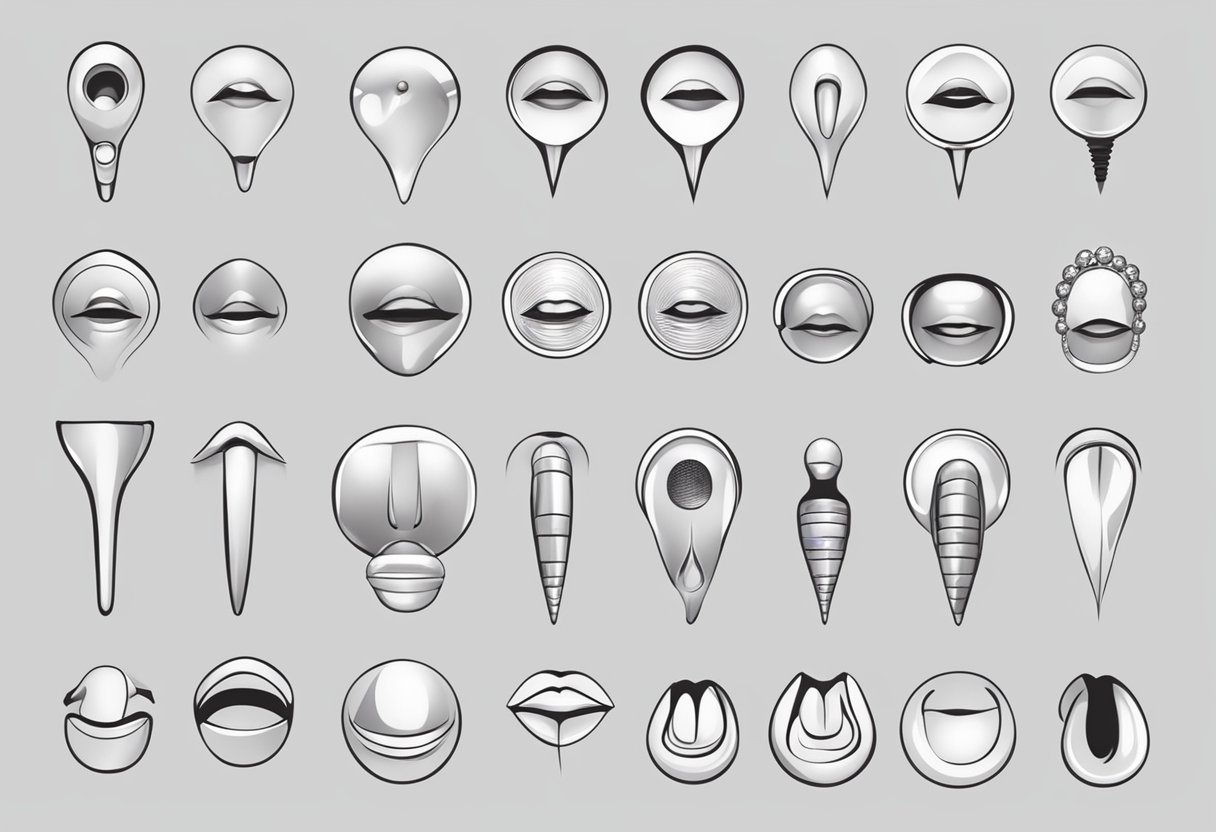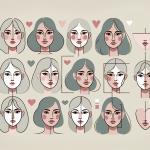Types Of Piercings
Body piercings have been a part of human culture for thousands of years. Today, piercings are a popular form of self-expression and can be found on people of all ages and backgrounds. Piercings can be placed anywhere on the body, and there are many different types of piercings to choose from.

Ear piercings are the most common type of piercing, and they can be placed in various locations on the ear, including the lobe, cartilage, and helix. Facial and oral piercings are also popular, and can be placed on the nose, eyebrow, lip, or tongue. Body and surface piercings, such as navel and nipple piercings, are also common. Finally, genital piercings are a more intimate form of piercing that can be placed on both men and women.
Key Takeaways:
- Piercings can be placed anywhere on the body, and there are many different types of piercings to choose from.
- Ear piercings are the most common type of piercing, followed by facial and oral piercings, body and surface piercings, and genital piercings.
- Proper aftercare and safety measures are essential for all types of piercings to prevent infection and promote healing.
Ear Piercings Explained
When it comes to ear piercings, there are a variety of options to choose from. In this section, we will cover some of the most popular types of ear piercings, including lobe and cartilage piercings, industrial and tragus piercings, and helix and conch variations.
Lobe and Cartilage Piercings
Lobe piercings are the most common type of ear piercing. They are located on the fleshy part of the earlobe and are generally considered to be the easiest type of piercing to heal. Cartilage piercings, on the other hand, are located on the harder, outer part of the ear. They can take longer to heal and are generally considered to be more painful than lobe piercings.
Industrial and Tragus Piercings
Industrial piercings are a type of cartilage piercing that involves two holes connected by a single piece of jewelry. They are typically located on the upper ear and can take longer to heal than other types of piercings. Tragus piercings are located on the small flap of cartilage that covers the ear canal. They can be more painful than other types of piercings, but they are generally considered to be easy to care for.
Helix and Conch Variations
Helix piercings are located on the upper part of the ear, just above the lobe. They can be done in a variety of different ways, including forward helix piercings and double helix piercings. Conch piercings are located on the inner part of the ear, and can be done in either the outer or inner conch. They can be more painful than other types of piercings, but they are generally considered to be easy to care for.
Overall, there are many different types of ear piercings to choose from, each with its own unique benefits and drawbacks. Whether you’re looking for a simple lobe piercing or a more complex industrial piercing, there is sure to be a type of ear piercing that is right for you.
Facial and Oral Piercings
Facial and oral piercings have been around for centuries and have become increasingly popular in recent years. From nose piercings to lip piercings, there are many different types of facial and oral piercings to choose from. In this section, we will explore some of the most popular facial and oral piercings, including nose and septum piercings, lip and cheek piercings, and eyebrow and bridge varieties.
Nose and Septum Piercings
Nose piercings are one of the most common types of facial piercings. They can be done on either side of the nose or through the septum. Nostril piercings are the most popular type of nose piercing. Septum piercings are also quite common and involve piercing the cartilage between the nostrils.
It is important to note that nose piercings take quite a long time to heal, as they go through cartilage, not flesh. It is essential to keep the piercing clean and avoid touching it to prevent infection.
Lip and Cheek Piercings
Lip and cheek piercings are another popular type of facial piercing. Lip piercings are often done on the lower lip and can be done in various styles, such as a labret piercing or a Monroe piercing. Cheek piercings are less common but involve piercing the cheek.
Like nose piercings, lip and cheek piercings take time to heal and require proper care to prevent infection. It is essential to follow aftercare instructions carefully and avoid eating or drinking anything that could irritate the piercing.
Eyebrow and Bridge Varieties
Eyebrow and bridge piercings are popular facial piercings that involve piercing the eyebrow or the bridge of the nose. Eyebrow piercings are typically done vertically, while bridge piercings are done horizontally.
Like all piercings, eyebrow and bridge piercings require proper care to prevent infection. It is essential to keep the piercing clean and avoid touching it to prevent irritation.
Overall, facial and oral piercings are a great way to express individuality and add some personality to your appearance. However, it is essential to do your research and choose a reputable piercer to ensure that the piercing is done safely and correctly.
Body and Surface Piercings
Body and surface piercings are a popular way to express one’s individuality and style. These piercings are typically done on areas of the body that are not commonly pierced, such as the nipples, navel, and surface areas of the skin.
Nipple and Navel Piercings
Nipple and navel piercings are becoming increasingly popular among both men and women. Nipple piercings are done on the areola and can be either horizontal or vertical. They can be adorned with barbells, rings, or other jewelry. Navel piercings, also known as belly button piercings, are done on the skin around the navel and can be adorned with a variety of jewelry such as curved barbells, rings, or studs.
When getting a nipple or navel piercing, it is important to choose a reputable piercer who uses high-quality jewelry and follows proper sterilization procedures. It is also important to follow aftercare instructions to ensure proper healing.
Dermal and Uncommon Placements
Dermal piercings, also known as microdermal piercings, are a type of surface piercing where a small anchor is placed under the skin and a piece of jewelry is attached to the anchor. These piercings can be done on a variety of areas such as the nape of the neck, chest, or wrist.
Uncommon placements for body and surface piercings include corset piercings, which are a series of piercings done down the back that are laced together like a corset, and surface piercings on areas such as the collarbone or hips.
When considering a body or surface piercing, it is important to do research and choose a reputable piercer who uses high-quality jewelry and follows proper sterilization procedures. It is also important to follow aftercare instructions to ensure proper healing and minimize the risk of infection or other complications.
Genital Piercings
Genital piercings are a type of body piercing that involves piercing a part of the genitalia to create a suitable place for wearing different types of jewelry. They are becoming increasingly popular among people of all genders and ual orientations. However, it is important to note that genital piercings are not suitable for everyone and require proper aftercare to avoid infections or complications.
Male Genital Piercings
There are several types of male genital piercings, including the Prince Albert, Ampallang, Dydoe, and Frenum piercing. The Prince Albert piercing is the most common type of male genital piercing, and it involves piercing the skin on the underside of the penis. This type of piercing is said to enhance ual pleasure and can be worn with different types of jewelry.
The Ampallang piercing is another popular type of male genital piercing, which involves piercing the head of the penis horizontally. This type of piercing is said to provide intense stimulation during ual activity and can be worn with a curved barbell or ring.
The Dydoe piercing involves piercing the ridge of the penis head, while the Frenum piercing involves piercing the skin on the underside of the penis shaft. Both of these piercings are said to enhance ual pleasure and can be worn with different types of jewelry.
Female Genital Piercings
Female genital piercings are also becoming increasingly popular, with the most common types being the Vertical Clitoral Hood (VCH) and Christina piercing. The VCH piercing involves piercing the skin above the clitoris, while the Christina piercing involves piercing the skin at the top of the pubic mound.
The VCH piercing is said to enhance ual pleasure and can be worn with different types of jewelry, including curved barbells or rings. The Christina piercing, on the other hand, is more of a decorative piercing and is typically worn with a curved barbell.
It is important to note that genital piercings, both male and female, require proper aftercare to avoid infections or complications. It is also recommended to consult with a professional piercer who has experience with genital piercings before getting one.
Aftercare and Safety
After getting a piercing, it is essential to take proper care of it to prevent complications and ensure proper healing. Here are some tips for aftercare and safety:
- Always wash your hands before touching the piercing to prevent infection.
- Avoid twisting, spinning, or rotating your jewelry during the healing process.
- Exercise and sweating are fine, but avoid activities that could jostle or aggravate the piercing.
- Use a saline solution or mild soap to clean the piercing twice a day.
- Avoid using alcohol, hydrogen peroxide, or any harsh chemicals on the piercing.
- Be patient, as healing time can vary depending on the type of piercing and individual factors.
- Follow the aftercare instructions provided by your piercer.
It is important to choose a reputable piercer who uses a sterilized needle instead of a gun, which can cause damage to the tissue and increase the risk of infection. The jewelry used should also be of high-quality and suitable for the type of piercing.
While some pain and discomfort can be expected during and after the piercing, excessive pain or signs of infection should be reported to a doctor or piercer immediately. With proper aftercare and safety measures, most piercings can heal without complications and provide a unique form of self-expression.






